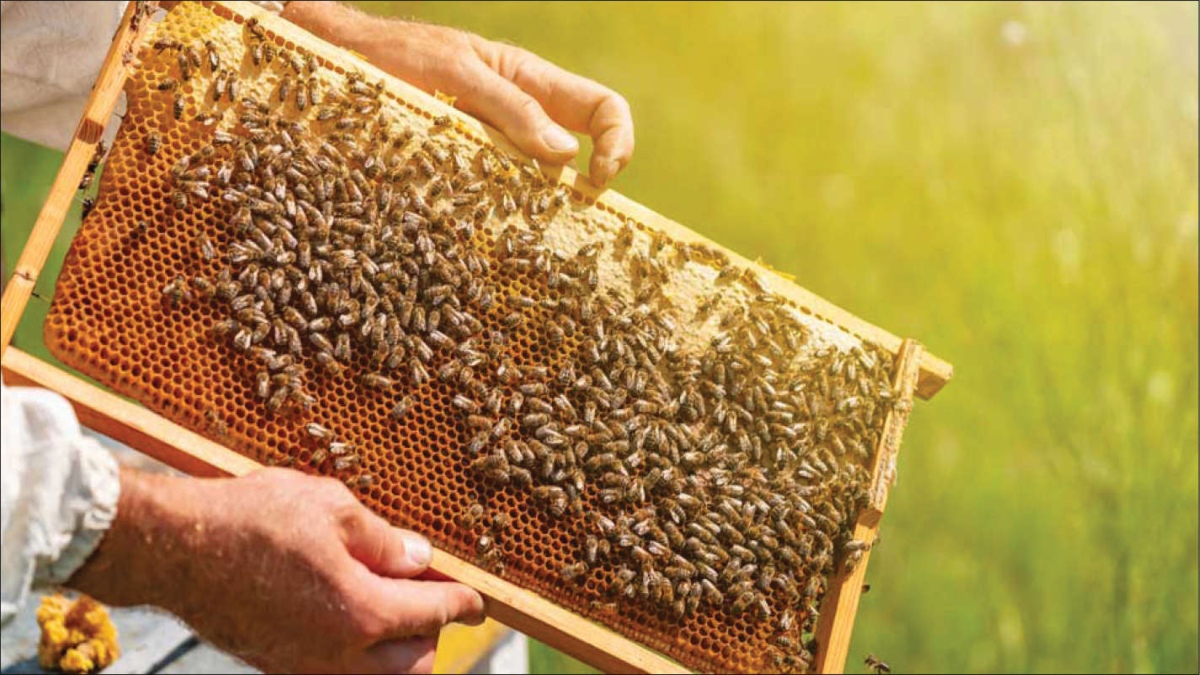“That land is barren, whose air falls silent of the buzz of the bees.”
Small things affecting our world in a big way is not a new perception. We know how micro-nutrients in ever small quantities influence biomass production, how mosquitoes and insects can cause and spread pandemics and how the accumulation of small amounts of carbon in the atmosphere over time has resulted in the gigantic phenomenon of climate change. Similarly, the relevance of the honey bee to the life system on the planet is critically important. And even great minds like Albert Einstein have said that if honey bees disappear, it could threaten the very survival of humanity.

The fact that honey bees can pollinate flowers and effectively author agricultural production makes the interdependence of man and nature a sustainable characteristic of organic evolution. So, simply put, as many have done in the past, if bees exist, we exist. And if they don’t, it will not be too long before the life system’s sustainability begins to crumble.
India has not been an exception to this global appreciation of the bee. In a general sense, what is said about the world is what applies, in a very critical manner, to highly productive tropical systems like the kind in India. Bees pollinate 90% of the flowering plants and over 70% of the main agricultural crops on which we sustain ourselves. India forms about 18% of the world’s population, and about 60% of the Indian population is engaged in agriculture and rural enterprises. With this fact in the picture, it does not require much imagination to assume that the spiral of eventualities caused by a decline of bees in India alone can affect human welfare around the world significantly. In fact, the industrial economies of the world owe it to the agricultural economies when it comes to survival and prosperity. And as such, bees must be seen as a potential single-point failure system in which, if we fail them, they could fail an entire civilisation.
India has a National Honey Mission, executed by the Khadi and Village Industries Commission, functioning under the auspices of the Ministry of MSME, Government of India. This National Honey Mission became necessary due to a few critical factors of global importance as they unfolded around us in the decade between 2000 and 2010.
First, climate change-related warming was suspected to have shifted the niche domain of both forest and agricultural ecosystems to some extent, which not only displaced the biodiversity to newer landscapes, but also exacerbated species loss and productivity loss. Although not well recorded in terms of numbers, it became very noticeable that tribal communities that traditionally harvested honey from well-known trees, groves and locations had to move to newer micro-climates in the forests in search of honeycombs. The bumblebee had already been listed as endangered and several honey bee species came under watch. India is known to have some 796 species of bees and 40% of them are endemic to our geography. However, the species conservation debate largely focused on big cats, elephants and rhinos but the overarching importance of these creatures was underestimated. And hugely important ecosystems, apart from farmlands, like the Sundarbans, Western Ghats and the verdant Northeastern landscapes, remained fragile with the possibility that the effect of climate change on bees could disrupt their integrity in the long run.
Second, the last decade saw an increasing incidence of ‘colony collapse disorder’ (CCD) concerning bees, especially the four or five species in India which have high relevance to bee farming. Being in the middle of a communication revolution, with mobile phone networks as well as television channels booming and enlarging national signal footprints, the CCD was suspected to be the handiwork of invisible electromagnetic signals. No conclusive evidence is available on this, but the CCD is a recorded fact and large populations of Indian bees of high commercial importance for beekeeping as well as agriculture have witnessed sharp declines in several geographic locations.
Third, the enormous increase in the application of insecticides in agriculture, especially the neonicotinoids, has been blamed for destroying honey bee populations to a very large extent in India in the past.
With these, the bee situation, over a period of time, had come to be a really complex consideration. The desire to increase agricultural productivity, however, did not come with the desire to conserve and protect the diversity and population of bees in India, especially in the first decade of this century, spilling into the middle of this decade till about 2015. The policy horizon on agricultural development in the first decade did not include the importance of restoring and increasing bee populations.
By the middle of the current decade, India’s ranking on the food security index and global hunger index were not too impressive. India’s position among the biggest honey producers in the world was just the 8th and there was a need to explore the issue, if it could be raised.
The Government of India, under the leadership of Prime Minister Narendra Modi, had begun to work on several areas of resurgence of India in a very focused manner, and the fields of agriculture, environment, biodiversity and sustainable development as a mutually linked quartet had already emerged as a significant direction of development. Among many other priorities, the Khadi and Village Industries Commission (KVIC) was encouraged to take up the Honey Mission as an important programme. By then, the Honey Mission was a point of focus for the National Bee Board of the Ministry of Agriculture as well, along with the sporadic efforts by the state governments.
However, KVIC had the unique advantage of being the lead agency under the government for the Prime Minister’s Employment Generation Programme (PMEGP) and it was envisaged that beekeeping is best suited as an entrepreneurial activity, benefiting under the PMEGP and other related initiatives. The urgency before the nation in the context of the mandate of the National Honey Mission for KVIC was about increasing honey production, bee population, conservation of bee biodiversity and building related advantages for agricultural productivity. Further, reining in the rising unemployment rate, increasing the income of small farmers, building entrepreneurial spirit, ensuring self-sufficiency as well as increasing the export of honey were all equally required objectives. With this background, the KVIC established the National Honey Mission in 2017-18.
The National Honey Mission at KVIC thus came with significant expectations, such as increasing the production of honey, promoting the vocation of beekeeping, employment generation and assistance to agricultural development. Alongside, India has been addressing other highly relevant issues, so that there is a comprehensive approach to improvement in food security, biodiversity, environmental protection and entrepreneurship among the rural populations. Twenty-seven pesticides were also seriously reviewed to be banned from agricultural use in the country, which was a very good supporting legislation for the Honey Mission by the Government of India. The Paris Declaration on climate change had been signed too, so that the incidence of CFC was being controlled as per India’s international obligations, protecting fragile ecosystems from stress and directly helping bee populations to thrive. The Prime Minister of India and the Indian Finance Ministry also began emphasizing on Zero Budget Natural Farming (ZBNF), whereby the proliferation of the benefits of the Honey Mission would be possible. More recently, the Aatmanirbhar Bharat programme, emphasizing on self-reliance, has given further impetus to these efforts.
With an all-round support system being evolved in the national mainstream flow of policy horizon, the KVIC launched the Honey Mission during 2017-18 with the simple goal of training people in beekeeping, providing bee boxes with hives, giving technical support till full establishment, developing cluster facilities of honey extraction and processing infrastructure and creating marketing facilities for the sale of honey products. The KVIC also evolved a gender equality policy and particularly encouraged women to take up entrepreneurship. As for pan-India equality in development as well as for strengthening the provisions of the social justice framework, special emphasis on Northeastern and northern hilly states of India and other socio-culturally underprivileged communities were prioritized and given higher access to the benefits of the Mission.
In the past three years, the National Honey Mission of KVIC has distributed about 150,000 bee boxes with live colonies across the country. With each trained individual receiving a hamper of 10 bee boxes, a tenth of that number is the quantum of apiaries established. If each of these 15,000 apiaries employs even three or four local people and two or three people for sales and distribution of honey, the wider employment opportunities will keep expanding. Further, through the associated national programmes of cluster development and assistance, the KVIC has established dozens of infrastructure pools, where entrepreneurs can avail facilities for honey extraction, processing, bottling, ancillary product development and knowledge exchange.
The National Honey Mission of KVIC is an aggressive nationwide programme, which has already resulted in the increase of bee populations by around 7,500 million individuals and is helping the nation take honey production to the level of $400 million. 17 classes of pesticides have been banned by the Government of India in recent months, out of a list of 27 under consideration, which will lead to the retention of the bee population that KVIC’s Honey Mission has generated. Skill development, training in beekeeping, marketing of honey and cluster-based infrastructure development have increased self-reliance in the sector to a large extent. Due to the increasing abundance of pure honey within the country, the contamination of honey by profiteers by way of adding imported rice syrup from neighbouring countries has been largely checkmated. During the current financial year, it is estimated that the food grain production would be about 300 million tonnes, which is a gradual increase at the rate of 2-3% in the past two financial years during the operation of the National Honey Mission.
The National Honey Mission of the KVIC is an integrated effort for multi-goal achievement, directly contributing to several national priorities like increasing bee population, enhancing food security, developing skill sets, establishing nationwide infrastructure, employing rural youth and women, ensuring self-sufficiency in honey and subtly build robustness into environmental systems across the geographies of the country for climate change adaptation and sustainability of resource dependent society.
The Prime Minister has called this the “Sweet Revolution” of the century and holds this as an important initiative, gradually strengthening the core competence of India. The KVIC has been expanding its efforts, year after year, and the National Honey Mission is evolving as a harbinger of harmony between the environment, society and economic system. It has also become a leading example of rural entrepreneurship and sustainable development through multiple indicators tagged to international programmes like UN-SDGs.
The writer is Chairman, Khadi and Village Industries Commission, Government of India. The views expressed are personal.























